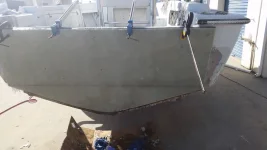Triskele
Well-known member
- Joined
- Nov 16, 2012
- Messages
- 264
- Status
- OWNER - I own a Hatteras Yacht
- Hatteras Model
- 43' DOUBLE CABIN (1970 - 1984)
Am repairing deck core under bow pulpit and forward of bulkhead on bow. Roughly a 30 sq. ft. section or one 4' x 8' sheet. Core is 5/8" thick. Since the area requires structural integrity and the ability to bear the loads of the anchor windlass, bow pulpit and cleats, based upon all that I have read plywood is probably the best replacement for the rotted balsa that has come out (at this stage I have removed the balsa and am in the process of sanding inside upper skin and prepping area to take the new core. I am working from the bottom...as in, I have removed the bottom skin. The work is also confined to a limited space inside the ship's anchor locker.) So here's my question(s)...does anyone see a concern with using a sheet of 3/8" plywood on top and a sheet of 1/4" nida-core on bottom? Is that doable? Can they be laminated together with epoxy? Also, will I maintain the structural integrity of a solid sheet of 5/8" plywood? Given the area I am working in, it will be impossible to put in one solid sheet of plywood so I will have to laminate two pieces together and overlap the seams. However, although I intend to "pretreat" each plywood sheet with epoxy to ensure it has a moisture barrier and bonds well, I was thinking that using Nida-core as one of my layers instead of plywood. It is lightweight, durable and plastic honeycomb. Thus, structurally sound and water resistant. However, not sure how well it would stand up to the test of time and degradation or whether it is appropriate for my application around the bow pulpit and windlass.
I have seen in other threads on this subject where others have recommended Divinycell, Coosa board and the like. I do not believe that these alone are appropriate for an area that would have to sustain the loads of the bow pulpit and anchor. As well, they can not be screwed into like can be done with plywood if necessary. Thus, I have ruled these alternatives out. Would possibly consider them in combination with a plywood layer, but seems that Nida-core might be a better choice depending on its bonding ability with plywood. Or perhaps it would just be better to stick with plywood all around. Thoughts?
I have seen in other threads on this subject where others have recommended Divinycell, Coosa board and the like. I do not believe that these alone are appropriate for an area that would have to sustain the loads of the bow pulpit and anchor. As well, they can not be screwed into like can be done with plywood if necessary. Thus, I have ruled these alternatives out. Would possibly consider them in combination with a plywood layer, but seems that Nida-core might be a better choice depending on its bonding ability with plywood. Or perhaps it would just be better to stick with plywood all around. Thoughts?
Last edited:


![20161123_121916[1].webp](/data/attachments/11/11680-7e3c64a0f97aefe413cb8b73ec8e4d38.jpg?hash=wTa-g178PE)
